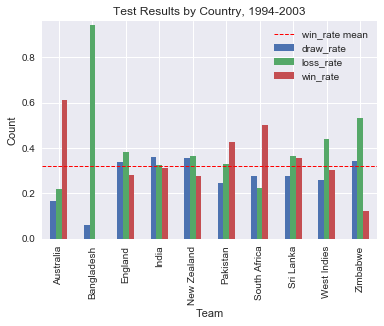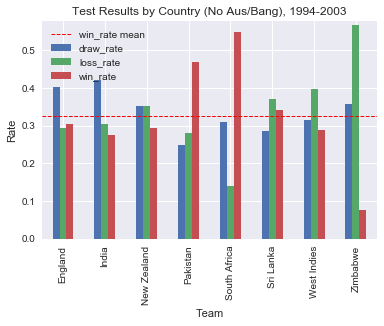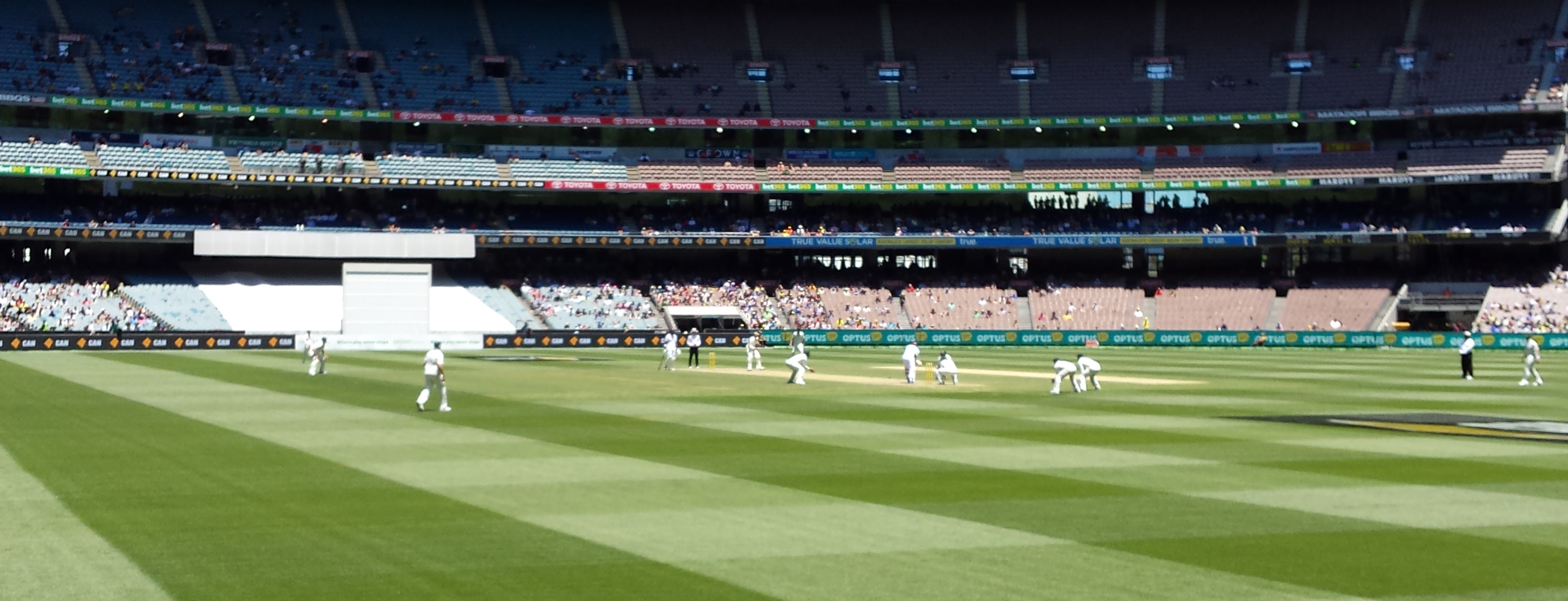England Test Results 1994 To 2003
Test Cricket - How bad were England between 1994 and 2003?
Introduction - Why this question?
A recent ESPNCricinfo article debating Dale Steyn’s place in the fast bowlers pantheon caught my attention. Not for the mass of stats thrown out to prove the writers point that Dale could well be the Greatest Of All Time (though there were indeed a lot of stats thrown), but for a line dismissing the acheivements of Glenn McGrath, his closest modern day rival for that title. The full quote, with the offending line in bold:
‘ESPNcricinfo’s jury panel recently voted in McGrath as the right-arm quick in our Test team of the last 25 years, but given the above numbers, I would replace McGrath with Steyn, owing not only to Steyn’s prowess on the toughest continent for quicks, but also because of the value he adds via his strike rate. A full fifth of McGrath’s wickets had also come against minnows, by which of course I mean England 1994 through 2003.’
The line may well be intentionally provocative or just tongue in cheek, but it got me thinking, how bad were England in this era? Lets take a closer look.
Methodology
ESPNCricinfo has an excellent searchable archive engine called Statsguru, from which I ran the appropriate searches to get our raw data. I’ve created a very similar function to that in my PGA Putting Analysis blog post, where the URL’s of these search results can be inputted into the function and a dataframe is returned. The resulting dataframes will then be merged and cleaned for analysis.
#Import required modules
import requests
from bs4 import BeautifulSoup as soup
import pandas as pd
#Function
def statsguru_url_to_df(url):
"""Turn a statsguru stats page url into a DataFrame"""
#Package the request, send request, catch response: r
r = requests.get(url)
#Extract the response as HTML: html_doc
html_doc = r.text
#Create our Beautiful Soup object from the HTML: main_soup
main_soup = soup(html_doc, 'lxml')
#Find our table in the soup. There are a number of tables in the soup and unfortunately they dont have distinguishable attributes
all_tables = main_soup.find_all('table')
#It turns out our required table is the 3rd in the list. NOTE - not robust if site changes format of the page in future
stat_table = all_tables[2]
#Find elements in the 'body' of the table
stat_table_body = stat_table.find('tbody')
#Initialize an empty array
stat_data = []
#Filter for the rows in the table body
rows = stat_table_body('tr')
for match in rows:
#select all cells in the row
cols = match.find_all('td')
#Strip out empty values
cols = [ele.text.strip() for ele in cols]
#Append data to our array
stat_data.append([ele for ele in cols if ele])
#Sort the table header, using same process as above for the table body
stat_table_header = stat_table.find('thead')
stat_header = []
hrows = stat_table_header('tr')
for header in hrows:
cols = header.find_all('th')
cols = [ele.text.strip() for ele in cols]
#Append data to our array
stat_header.append([ele for ele in cols if ele])
#Create our header array
stat_col_labels = stat_header[0]
#Return a DataFrame of the data
return pd.DataFrame(stat_data, columns=stat_col_labels)
Lets use this function by inputting the URL’s from our Statsguru search results, then merge the resulting DataFrames.
#Use our function to get Englands results v all teams 1994-2003
url_1 = 'http://stats.espncricinfo.com/ci/engine/stats/index.html?class=1;filter=advanced;orderby=start;size=200;spanmax1=01+Jan+2003;spanmin1=01+Jan+1994;spanval1=span;template=results;type=team;view=results'
all_results_df_1 = statsguru_url_to_df(url_1)
url_2 = 'http://stats.espncricinfo.com/ci/engine/stats/index.html?class=1;filter=advanced;orderby=start;page=2;size=200;spanmax1=01+Jan+2003;spanmin1=01+Jan+1994;spanval1=span;template=results;type=team;view=results'
all_results_df_2 = statsguru_url_to_df(url_2)
url_3 = 'http://stats.espncricinfo.com/ci/engine/stats/index.html?class=1;filter=advanced;orderby=start;page=3;size=200;spanmax1=01+Jan+2003;spanmin1=01+Jan+1994;spanval1=span;template=results;type=team;view=results'
all_results_df_3 = statsguru_url_to_df(url_3)
url_4 = 'http://stats.espncricinfo.com/ci/engine/stats/index.html?class=1;filter=advanced;orderby=start;page=4;size=200;spanmax1=01+Jan+2003;spanmin1=01+Jan+1994;spanval1=span;template=results;type=team;view=results'
all_results_df_4 = statsguru_url_to_df(url_4)
#Concatenate these 4 DFs into a single DF
all_results = [all_results_df_1, all_results_df_2, all_results_df_3, all_results_df_4]
all_results_df = pd.concat(all_results)
print(all_results_df.head())
print(all_results_df.shape)
print(all_results_df.info())
Team Result Margin Toss Bat Opposition Ground \
0 South Africa won 5 runs won 1st v Australia Sydney
1 Australia lost 5 runs lost 2nd v South Africa Sydney
2 India won inns & 119 runs won 1st v Sri Lanka Lucknow
3 Sri Lanka lost inns & 119 runs lost 2nd v India Lucknow
4 India won inns & 95 runs won 1st v Sri Lanka Bengaluru
Start Date
0 2 Jan 1994
1 2 Jan 1994
2 18 Jan 1994
3 18 Jan 1994
4 26 Jan 1994
(794, 8)
<class 'pandas.core.frame.DataFrame'>
Int64Index: 794 entries, 0 to 193
Data columns (total 8 columns):
Team 794 non-null object
Result 794 non-null object
Margin 794 non-null object
Toss 794 non-null object
Bat 794 non-null object
Opposition 794 non-null object
Ground 794 non-null object
Start Date 794 non-null object
dtypes: object(8)
memory usage: 55.8+ KB
None
Now I’ll clean up the DataFrame so it contains the required data in a meaningful form.
#Select our required columns
all_results_df = all_results_df.loc[:, ('Team', 'Result')]
print(all_results_df.head())
#Reshape the data. First sort results into relevant groups
all_grouped = all_results_df.groupby(['Team'])['Result'].value_counts()
print(all_grouped)
#Turn this into a dataframe by unstacking our groupby object
all_group_df = all_grouped.unstack()
print(all_group_df)
#Note - we have a hierarchical index here
#Lets deal with our NaN values. 'aban' and 'canc' matches can be disregarded for this analysis. Just for practice we will deal with them using .dropna()
all_cleanish_group_df = all_group_df.dropna(axis ='columns', thresh=5)
#Bangladesh didnt win a test in the period, so this NaN needs replacing as 0
all_cleaner_group_df = all_cleanish_group_df.fillna(0)
#We will convert to integers from floating point values as in this case it makes sense, you cant win a fraction a match.
all_final_df = all_cleaner_group_df.astype('int64')
print(all_final_df)
#Lets put it into ratios. We'll start by adding a total matches column
all_final_df['Total'] = all_final_df['draw'] + all_final_df['lost'] + all_final_df['won']
#Then create the ratio columns
all_final_df['draw_rate'] = all_final_df['draw'] / all_final_df['Total']
all_final_df['loss_rate'] = all_final_df['lost'] / all_final_df['Total']
all_final_df['win_rate'] = all_final_df['won'] / all_final_df['Total']
print(all_final_df)
Team Result
0 South Africa won
1 Australia lost
2 India won
3 Sri Lanka lost
4 India won
Team Result
Australia won 62
lost 22
draw 17
Bangladesh lost 16
draw 1
England lost 41
draw 36
won 30
India draw 29
lost 26
won 25
aban 1
New Zealand lost 29
draw 28
won 22
aban 1
canc 1
Pakistan won 35
lost 27
draw 20
canc 2
aban 1
South Africa won 45
draw 25
lost 20
Sri Lanka lost 29
won 28
draw 22
canc 1
West Indies lost 41
won 28
draw 24
Zimbabwe lost 31
draw 20
won 7
aban 1
Name: Result, dtype: int64
Result aban canc draw lost won
Team
Australia NaN NaN 17.0 22.0 62.0
Bangladesh NaN NaN 1.0 16.0 NaN
England NaN NaN 36.0 41.0 30.0
India 1.0 NaN 29.0 26.0 25.0
New Zealand 1.0 1.0 28.0 29.0 22.0
Pakistan 1.0 2.0 20.0 27.0 35.0
South Africa NaN NaN 25.0 20.0 45.0
Sri Lanka NaN 1.0 22.0 29.0 28.0
West Indies NaN NaN 24.0 41.0 28.0
Zimbabwe 1.0 NaN 20.0 31.0 7.0
Result draw lost won
Team
Australia 17 22 62
Bangladesh 1 16 0
England 36 41 30
India 29 26 25
New Zealand 28 29 22
Pakistan 20 27 35
South Africa 25 20 45
Sri Lanka 22 29 28
West Indies 24 41 28
Zimbabwe 20 31 7
Result draw lost won Total draw_rate loss_rate win_rate
Team
Australia 17 22 62 101 0.168317 0.217822 0.613861
Bangladesh 1 16 0 17 0.058824 0.941176 0.000000
England 36 41 30 107 0.336449 0.383178 0.280374
India 29 26 25 80 0.362500 0.325000 0.312500
New Zealand 28 29 22 79 0.354430 0.367089 0.278481
Pakistan 20 27 35 82 0.243902 0.329268 0.426829
South Africa 25 20 45 90 0.277778 0.222222 0.500000
Sri Lanka 22 29 28 79 0.278481 0.367089 0.354430
West Indies 24 41 28 93 0.258065 0.440860 0.301075
Zimbabwe 20 31 7 58 0.344828 0.534483 0.120690
Analysis
Now we have our cleaned up DataFrame lets do some simple empirical data analysis (EDA) and look at some descriptive stats.
#Summary stats
print(all_final_df.describe())
Result draw lost won Total draw_rate loss_rate \
count 10.000000 10.00000 10.000000 10.000000 10.000000 10.000000
mean 22.200000 28.20000 28.200000 78.600000 0.268357 0.412819
std 9.235198 8.14862 17.535995 25.556908 0.095198 0.207861
min 1.000000 16.00000 0.000000 17.000000 0.058824 0.217822
25% 20.000000 23.00000 22.750000 79.000000 0.247443 0.326067
50% 23.000000 28.00000 28.000000 81.000000 0.278129 0.367089
75% 27.250000 30.50000 33.750000 92.250000 0.342733 0.426440
max 36.000000 41.00000 62.000000 107.000000 0.362500 0.941176
Result win_rate
count 10.000000
mean 0.318824
std 0.175490
min 0.000000
25% 0.278954
50% 0.306788
75% 0.408730
max 0.613861
England have a mean win rate of 0.280, which is slightly worse than the overall mean (0.319) and median (0.307) win rates. Their loss rate of 0.383 (a lower number here is better) is slightly worse than the median loss rate (0.367), but better than the mean loss rate (0.413), though Bangladesh do skew the means somewhat as they had just started playing test cricket and were on the whole very uncompetitive.
#Lets do some graphical EDA.
import matplotlib.pyplot as plt
import seaborn as sns
#Set Seaborn as default
sns.set()
#Create a bar plot
all_final_df.plot(y=['draw_rate', 'loss_rate', 'win_rate'], kind='bar')
#Add a line for the mean win rate of the data
plt.axhline(y=all_final_df['win_rate'].mean(), color='red', linewidth=1, label='win_rate mean', linestyle='--')
plt.xlabel('Team')
plt.ylabel('Count')
plt.legend(loc='upper right')
plt.title('Test Results by Country, 1994-2003')
plt.margins(0.02)
plt.show()

Thoughts
We can see clearly that Australia have by far the largest win rate, twice that of the mean, while the limitations of Bangladesh during the era are also obvious.
Australia, South Africa, Pakistan and Sri Lanka clearly have better records than England, as do India though to a lesser extent. England look to have a roughly similar record to New Zealand and the West Indies. They are only obviously better than Zimbabwe and Bangladesh. Does this make them minnows during the period? Probably not, though they were certainly a sub par team.
But is this the whole story?
More Thoughts
During this period England played Australia (as we’ve seen, clearly the best team in the world at the time) 25 times, nearly a quarter of all their matches. Thats more than any other team played Australia. Also England played no tests at all against Bangladesh who didn’t win a single game out of the 17 they played in this era. What if we repeated the analysis removing all results involving Australia and Bangladesh, in a crude effort to equalize the difficulty of the schedules? Lets do that now.
#Use our function to get all non-Australia/Bangladesh results 1994-2003
urls_1 = 'http://stats.espncricinfo.com/ci/engine/stats/index.html?class=1;filter=advanced;opposition=1;opposition=3;opposition=4;opposition=5;opposition=6;opposition=7;opposition=8;opposition=9;orderby=start;size=200;spanmax1=01+Jan+2003;spanmin1=01+Jan+1994;spanval1=span;team=1;team=3;team=4;team=5;team=6;team=7;team=8;team=9;template=results;type=team;view=results;wrappertype=print'
filter_results_df_1 = statsguru_url_to_df(urls_1)
urls_2 = 'http://stats.espncricinfo.com/ci/engine/stats/index.html?class=1;filter=advanced;opposition=1;opposition=3;opposition=4;opposition=5;opposition=6;opposition=7;opposition=8;opposition=9;orderby=start;page=2;size=200;spanmax1=01+Jan+2003;spanmin1=01+Jan+1994;spanval1=span;team=1;team=3;team=4;team=5;team=6;team=7;team=8;team=9;template=results;type=team;view=results;wrappertype=print'
filter_results_df_2 = statsguru_url_to_df(urls_2)
urls_3 = 'http://stats.espncricinfo.com/ci/engine/stats/index.html?class=1;filter=advanced;opposition=1;opposition=3;opposition=4;opposition=5;opposition=6;opposition=7;opposition=8;opposition=9;orderby=start;page=3;size=200;spanmax1=01+Jan+2003;spanmin1=01+Jan+1994;spanval1=span;team=1;team=3;team=4;team=5;team=6;team=7;team=8;team=9;template=results;type=team;view=results;wrappertype=print'
filter_results_df_3 = statsguru_url_to_df(urls_3)
#Concatenate these 3 DFs into a single DF
filter_results = [filter_results_df_1, filter_results_df_2, filter_results_df_3]
filter_results_df = pd.concat(filter_results)
print(filter_results_df.head())
print(filter_results_df.shape)
print(filter_results_df.info())
Team Result Margin Toss Bat Opposition Ground \
0 India won inns & 119 runs won 1st v Sri Lanka Lucknow
1 Sri Lanka lost inns & 119 runs lost 2nd v India Lucknow
2 India won inns & 95 runs won 1st v Sri Lanka Bengaluru
3 Sri Lanka lost inns & 95 runs lost 2nd v India Bengaluru
4 India won inns & 17 runs lost 2nd v Sri Lanka Ahmedabad
Start Date
0 18 Jan 1994
1 18 Jan 1994
2 26 Jan 1994
3 26 Jan 1994
4 8 Feb 1994
(558, 8)
<class 'pandas.core.frame.DataFrame'>
Int64Index: 558 entries, 0 to 157
Data columns (total 8 columns):
Team 558 non-null object
Result 558 non-null object
Margin 558 non-null object
Toss 558 non-null object
Bat 558 non-null object
Opposition 558 non-null object
Ground 558 non-null object
Start Date 558 non-null object
dtypes: object(8)
memory usage: 39.2+ KB
None
Now to clean the data.
#Select our required columns
filter_results_df = filter_results_df.loc[:, ('Team', 'Result')]
print(filter_results_df.head())
#Reshape the data. First sort results into relevant groups
filter_grouped = filter_results_df.groupby(['Team'])['Result'].value_counts()
print(filter_grouped)
#Turn this into a dataframe by unstacking our groupby object
filter_group_df = filter_grouped.unstack()
print(filter_group_df)
#Note - we have a hierarchical index here
#Lets deal with our NaN values. 'aban' and 'canc' matches can be disregarded for this analysis. Just for practice we will deal with them using .dropna()
filter_cleanish_group_df = filter_group_df.dropna(axis ='columns', thresh=5)
#Bangladesh didnt win a test in the period, so this NaN needs replacing as 0
filter_cleaner_group_df = filter_cleanish_group_df.fillna(0)
#Convert to integers from floating point values as in this case it makes sense, you cant win half a match.
filter_final_df = filter_cleaner_group_df.astype('int64')
print(filter_final_df)
#Lets put it into ratios. We'll start by adding a total matches column
filter_final_df['Total'] = filter_final_df['draw'] + filter_final_df['lost'] + filter_final_df['won']
#Then create the ratio columns
filter_final_df['draw_rate'] = filter_final_df['draw'] / filter_final_df['Total']
filter_final_df['loss_rate'] = filter_final_df['lost'] / filter_final_df['Total']
filter_final_df['win_rate'] = filter_final_df['won'] / filter_final_df['Total']
print(filter_final_df)
Team Result
0 India won
1 Sri Lanka lost
2 India won
3 Sri Lanka lost
4 India won
Team Result
England draw 33
won 25
lost 24
India draw 29
lost 21
won 19
aban 1
New Zealand draw 24
lost 24
won 20
aban 1
canc 1
Pakistan won 30
lost 18
draw 16
canc 2
aban 1
South Africa won 39
draw 22
lost 10
Sri Lanka lost 26
won 24
draw 20
canc 1
West Indies lost 29
draw 23
won 21
Zimbabwe lost 30
draw 19
won 4
aban 1
Name: Result, dtype: int64
Result aban canc draw lost won
Team
England NaN NaN 33.0 24.0 25.0
India 1.0 NaN 29.0 21.0 19.0
New Zealand 1.0 1.0 24.0 24.0 20.0
Pakistan 1.0 2.0 16.0 18.0 30.0
South Africa NaN NaN 22.0 10.0 39.0
Sri Lanka NaN 1.0 20.0 26.0 24.0
West Indies NaN NaN 23.0 29.0 21.0
Zimbabwe 1.0 NaN 19.0 30.0 4.0
Result draw lost won
Team
England 33 24 25
India 29 21 19
New Zealand 24 24 20
Pakistan 16 18 30
South Africa 22 10 39
Sri Lanka 20 26 24
West Indies 23 29 21
Zimbabwe 19 30 4
Result draw lost won Total draw_rate loss_rate win_rate
Team
England 33 24 25 82 0.402439 0.292683 0.304878
India 29 21 19 69 0.420290 0.304348 0.275362
New Zealand 24 24 20 68 0.352941 0.352941 0.294118
Pakistan 16 18 30 64 0.250000 0.281250 0.468750
South Africa 22 10 39 71 0.309859 0.140845 0.549296
Sri Lanka 20 26 24 70 0.285714 0.371429 0.342857
West Indies 23 29 21 73 0.315068 0.397260 0.287671
Zimbabwe 19 30 4 53 0.358491 0.566038 0.075472
New Analysis
So what does this new analysis show?
#Summary stats
print(filter_final_df.describe())
Result draw lost won Total draw_rate loss_rate \
count 8.000000 8.000000 8.000000 8.00000 8.000000 8.000000
mean 23.250000 22.750000 22.750000 68.75000 0.336850 0.338349
std 5.496752 6.475228 9.996428 8.20714 0.057758 0.120789
min 16.000000 10.000000 4.000000 53.00000 0.250000 0.140845
25% 19.750000 20.250000 19.750000 67.00000 0.303823 0.289825
50% 22.500000 24.000000 22.500000 69.50000 0.334005 0.328645
75% 25.250000 26.750000 26.250000 71.50000 0.369478 0.377886
max 33.000000 30.000000 39.000000 82.00000 0.420290 0.566038
Result win_rate
count 8.000000
mean 0.324800
std 0.140800
min 0.075472
25% 0.284594
50% 0.299498
75% 0.374330
max 0.549296
#Our new bar plot
filter_final_df.plot(y=['draw_rate', 'loss_rate', 'win_rate'], kind='bar')
#Add a line for the mean win rate of the data
plt.axhline(y=filter_final_df['win_rate'].mean(), color='red', linewidth=1, label='win_rate mean', linestyle='--')
plt.xlabel('Team')
plt.ylabel('Rate')
plt.title('Test Results by Country (No Aus/Bang), 1994-2003')
plt.legend(loc='upper left')
plt.margins(0.02)
plt.show()

South Africa, Pakistan and Sri Lanka hold records better than the mean win rate (0.324). England have a win rate of 0.305, worse than the mean, but superior to the win rates of India, New Zealand, West Indies and Zimbabwe.
Englands loss rate of 0.293 is better than every other teams bar South Africa and Pakistan.
Conclusion
It looks as though England’s record suffered to some extent during the period by having to play a great team like Australia more than everyone else, while at the same time not having any matches against a genuine minnow, Bangladesh. With all matches against these two teams filtered out:
- Englands win rate improved slightly from 0.280 to 0.304
- their loss rate improved greatly from 0.383 to 0.293
Indeed if you were to rank the teams in this second analysis you could certainly make the case that England would be fourth out of eight, not exactly minnow like results. Perhaps Glenn McGraths 157 wickets against England shouldnt be dismissed as irrelevant just yet!

Leave a Comment